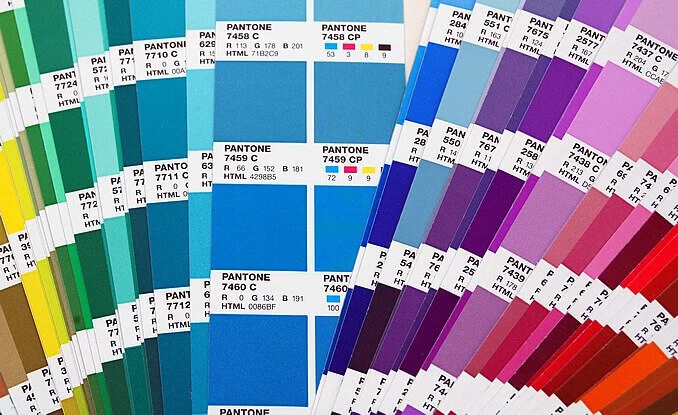

You can designate colors as either spot or process color types, which correspond to the two main ink types used in commercial printing. In the Swatches panel, you can identify the color type of color using icons that appear next to the name of the color.
Spot Colors
A spot color is a special premixed ink that is used instead of, or in addition to, process inks, and that requires its own printing plate on a printing press. Use spot color when few colors are specified and color accuracy is critical.
Keep the following guidelines in mind when specifying a spot color:
- For best results in printed documents, specify a spot color from a color-matching system supported by your commercial printer. Several color-matching system libraries are included with the software.
- Minimize the number of spot colors you use. Each spot color you create will generate an additional spot color printing plate for a printing press, increasing your printing costs. If you think you might require more than four colors, consider printing your document using process colors.
- You can use a spot color printing plate to apply a varnish over areas of a process color job. In this case, your print job would use a total of five inks—four process inks and one spot varnish.
About process colors
A process color is printed using a combination of the four standard process inks: cyan, magenta, yellow, and black (CMYK). Use process colors when a job requires so many colors that using individual spot inks would be expensive or impractical, as when printing color photographs.
- For best results in a high-quality printed document, specify process colors using CMYK values printed in process color reference charts, such as those available from a commercial printer.
- The final color values of a process color are its values in CMYK, so if you specify a process color using RGB (or LAB, in InDesign), those color values will be converted to CMYK when you print color separations. These conversions differ based on your color-management settings and document profile.
- Avoid using process colors in documents intended for online viewing only, because CMYK has a smaller color gamut than that of a typical monitor.

Use spot and process colors together
Sometimes it’s practical to use process and spot inks in the same job. For example, you might use one spot ink to print the exact color of a company logo on the same pages of an annual report where photographs are reproduced using process color. You can also use a spot color printing plate to apply a varnish over areas of a process color job. In both cases, your print job would use a total of five inks—four process inks and one spot ink or varnish.
Compare colors in InDesign and Illustrator
Adobe InDesign and Adobe Illustrator use slightly different methods for applying named colors. Illustrator lets you specify a named color as either global or nonglobal, and InDesign treats all unnamed colors as nonglobal, process colors.
The InDesign equivalents to global colors are swatches. Swatches make it easier to modify color schemes without having to locate and adjust each individual object. This is especially useful in standardized, production-driven documents like magazines. Because InDesign colors are linked to swatches in the Swatches panel, any change to a swatch affects all objects to which a color is applied.
The InDesign equivalents to nonglobal swatches are unnamed colors. Unnamed colors do not appear in the Swatches panel, and they do not automatically update throughout the document when the color is edited in the Color panel. You can, however, add an unnamed color to the Swatches panel later.
Knight Printing has been producing the highest quality printing in the region for nearly 130 years. We have the expertise and knowledge to bring your business and brand to life. If you want to leave a lasting impression with your customers, our team can guide you in new and exciting ways. Learn more about Knight Printing at knightprinting.com

